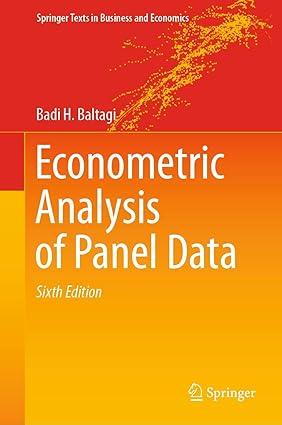Nested effects. This is based on problem 93.4.2 in Econometric Theory by Baltagi (1993). In many economic
Question:
Nested effects. This is based on problem 93.4.2 in Econometric Theory by Baltagi (1993). In many economic applications, the data may contain nested groupings. For example, data on firms may be grouped by industry and data on states by region and data on individuals by profession. In this case, one can control for unobserved industry and firm effects using a nested error component model. Consider the regression equation
\(y_{i j t}=x_{i j t}^{\prime} \beta+u_{i j t} \quad\) for \(i=1, \ldots, M ; j=1, \ldots, N \quad\) and \(\quad t=1,2, \ldots, T\)
where \(y_{i j t}\) could denote the output of the \(j\) th firm in the \(i\) th industry for the \(t\) th time period. \(x_{i j t}\) denotes a vector of \(k\) inputs, and the disturbance is given by
\[u_{i j t}=\mu_{i}+u_{i j}+\epsilon_{i j t}\]
where \(\mu_{i} \sim \operatorname{IID}\left(0, \sigma_{\mu}^{2}ight), u_{i j} \sim \operatorname{IID}\left(0, \sigma_{u}^{2}ight)\), and \(\epsilon_{i j t} \sim \operatorname{IID}\left(0, \sigma_{\epsilon}^{2}ight)\), independent of each other and among themselves. This assumes that there are \(M\) industries with \(N\) firms in each industry observed over \(T\) periods.
(1) Derive \(\Omega=E\left(u u^{\prime}ight)\) and obtain \(\Omega^{-1}\) and \(\Omega^{-1 / 2}\).
(2) Show that \(y^{*}=\sigma_{\epsilon} \Omega^{-1 / 2} y\) has a typical element \[
y_{i j t}^{*}=\left(y_{i j t}-\theta_{1} \bar{y}_{i j .}+\theta_{2} \bar{y}_{i . .}ight)\]
where \(\theta_{1}=1-\left(\sigma_{\epsilon} / \sigma_{1}ight)\) with \(\sigma_{1}^{2}=\left(T \sigma_{u}^{2}+\sigma_{\epsilon}^{2}ight) ; \theta_{2}=-\left(\sigma_{\epsilon} / \sigma_{1}ight)+\left(\sigma_{\epsilon} / \sigma_{2}ight)\) with \(\quad \sigma_{2}^{2}=\left(N T \sigma_{\mu}^{2}+T \sigma_{u}^{2}+\sigma_{\epsilon}^{2}ight) ; \quad \bar{y}_{i j}=\sum_{t=1}^{T} y_{i j t} / T \quad\) and \(\bar{y}_{i . .}=\sum_{j=1}^{N}\) \(\sum_{t=1}^{T} y_{i j t} / N T\). See solution 93.4.2 in Econometric Theory by Xiong (1995).
Step by Step Answer:






